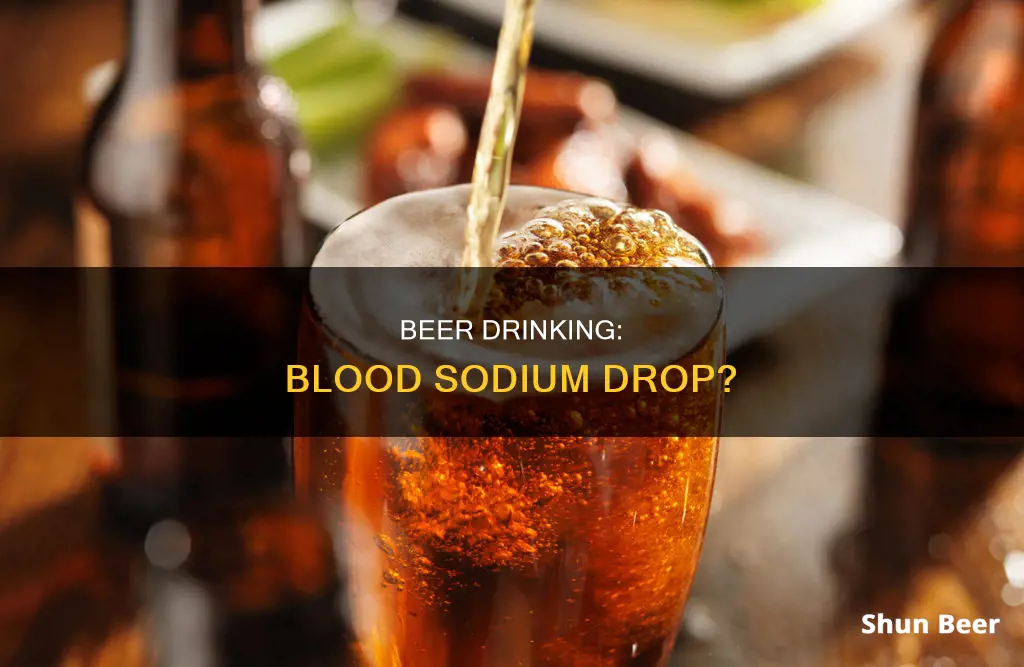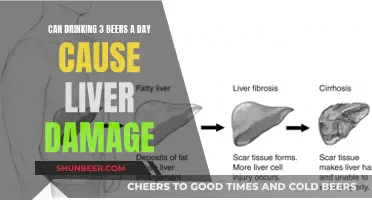
Drinking beer can lead to a drop in blood sodium levels, a condition known as beer potomania or beer drinker's hyponatremia. This occurs when excessive beer consumption, combined with poor dietary habits, results in a dilution of sodium in the bloodstream. Beer has a high water content and a low sodium content, which can trigger hyponatremia in high-risk individuals, particularly those with low sodium intake. This condition can have serious health consequences, including neurological problems and, in extreme cases, can become life-threatening.
| Characteristics | Values |
|---|---|
| What is beer potomania? | A condition in which the level of sodium in the bloodstream drops too low due to excessive beer consumption. |
| What causes beer potomania? | A combination of regularly binge drinking and a lack of proper eating and nourishment. |
| What are the symptoms of beer potomania? | Acutely altered mental state, muscle weakness, spasms or cramps, loss of energy or fatigue, irritability or restlessness, inability to wake (coma). |
| How is beer potomania treated? | Doctors may decide not to give IV fluids with sodium and instead put the patient on a liquid-restricted diet for at least 24 hours. Sodium may be administered slowly and carefully over the course of 48 hours to avoid causing osmotic demyelination syndrome (ODS). |
| How is beer potomania prevented? | By eating healthy and nutritious meals and reducing or avoiding alcohol intake. |
What You'll Learn

Beer contains a lot of water and little sodium
Beer potomania, or beer drinker's hyponatremia, is a condition that arises from excessive beer consumption coupled with poor dietary habits. Beer contains a lot of water and only a little sodium. This lopsided water-to-salt ratio, when combined with low sodium and protein-rich food intake, causes beer potomania in high-risk individuals.
The first case of severe hyponatremia, or low sodium in the blood, attributed to beer drinking was reported in 1972. Since then, the condition has been referred to as beer potomania. Beer has a low solute content, with a sodium concentration of 1.8 mEq/L and a potassium concentration of 7.2 mEq/L. This means that excessive beer consumption, especially when coupled with a poor diet, can result in severe hyponatremia.
Beer contains a lot of water, which can lead to water intoxication when consumed in large quantities. Water intoxication occurs when the body has more water than it can handle, leading to neuropsychiatric issues. Beer's high water content and low sodium content can cause fluid buildup in the cells, as there is not enough sodium in the body to regulate water balance. This is exacerbated by the water in beer, which further dilutes the sodium in the bloodstream.
The symptoms of beer potomania include an altered mental state, muscle weakness, spasms or cramps, fatigue, irritability, restlessness, and in severe cases, coma. Beer potomania is a serious condition that can be avoided by consuming a sufficient amount of healthy nutrients and reducing alcohol intake. It is important to note that treatment for beer potomania can be tricky and requires a delicate approach. While increasing sodium intake may seem like an obvious solution, doing so too rapidly can lead to neurological problems such as osmotic demyelination syndrome (ODS).
Beer and Zyrtec: What You Should Know
You may want to see also

Sodium regulates water balance in the body
Sodium is the principal cation of the extracellular space. It is the main substance dissolved in the body and is essential to our body. However, a high salt intake can raise blood pressure, which can damage the body in many ways over time.
The body maintains homeostasis by protecting sodium balance more vigorously than it does water balance or acid-base balance. Sodium balance occurs when sodium intake is equal to sodium loss. The body achieves this balance through the kidneys, which are our most important homeostatic control point for both sodium and water. The kidneys work to ensure that the water we consume in food and drink is equal to that of excretion.
The kidneys achieve this balance with the help of sensors from various parts of the body, such as the heart, blood vessels, and the brain, which provide feedback. The end goal is to preserve the plasma osmolality (saltiness) between 275-300 mOsm/kg and sodium levels between 135-145 mEq/L. When the plasma volume or sodium concentration gets too high, volume sensors in the heart, blood vessels, and kidneys detect this and set in motion processes that lead to their greater excretion through the kidneys. On the other hand, when the blood plasma volume or sodium concentration becomes too low, the sensors trigger processes that increase their reabsorption through the kidneys.
The body's endocrine system, a complex chemical messaging system made up of feedback loops of hormones, regulates both of these functions. The antidiuretic hormone (ADH), also known as vasopressin, is responsible for regulating the body's retention of water. It is secreted by the hypothalamus in response to an increase in plasma osmolality, decreased blood volume, decreased blood pressure, and/or stress. ADH acts on the nephrons of the kidneys, facilitating greater reabsorption of water by increasing the water permeability of the cell walls. This results in increased passive movement of water out of the kidney back into the bloodstream, leading to a reduced volume of urine.
In contrast, when there is an increase in total body water, plasma osmolality falls due to the relative decrease in sodium concentration. Under these conditions, water moves out of the extracellular fluid into the body cells, causing them to expand. Receptors within the cells respond to this swelling by signalling to the hypothalamus to slow down the secretion of ADH. With less circulating ADH, there is a reduction in the amount of water reabsorbed into the blood, and a greater volume of water is excreted in the urine, restoring fluid balance.
An excessive overconsumption of water can lead to the potentially fatal medical complication of hyponatremia (low sodium concentration in the blood). This condition can cause cells to swell irrationally, damaging or destroying cellular structure and disrupting normal cellular function. When this occurs in the brain cells, the condition can escalate from confusion to seizures, coma, or even death.
Therefore, the kidneys and the hormonal system play a vital role in helping the body achieve equilibrium when it comes to sodium and fluid balance.
Alcohol-Free Beer: A Safe Choice for Alcoholics?
You may want to see also

Sodium is needed for kidney function
Sodium is a vital mineral that plays a crucial role in maintaining the body's fluid balance and ensuring the proper functioning of nerves and muscles. While the body requires sodium to survive, excessive sodium intake can negatively impact health, especially if the kidneys are not functioning optimally.
The kidneys are responsible for regulating sodium and fluid balance in the body. When the kidneys are unhealthy, the body struggles to control sodium levels, leading to a build-up of sodium and fluid. This can result in various issues, including swollen ankles, puffiness, high blood pressure, shortness of breath, and fluid accumulation around the heart and lungs.
To maintain optimal kidney function, it is essential to limit sodium intake. A healthy diet should include no more than 2300 mg of sodium per day. By reducing sodium intake, individuals can help control their blood pressure and prevent discomfort during dialysis. Additionally, limiting sodium can help prevent fluid build-up, which can lead to hypertension and left ventricular hypertrophy, further worsening the prognosis for individuals with end-stage kidney disease.
In summary, sodium is essential for kidney function, but excessive sodium intake can impair kidney function and lead to various health complications. Therefore, maintaining a balanced sodium intake is crucial for overall health and kidney function.
Fruit Beer and Kids: Is It Safe?
You may want to see also

Low sodium can cause neurological issues
Low sodium, or hyponatremia, is a condition where sodium levels in the blood are lower than normal. Sodium is an essential mineral that plays a crucial role in maintaining the balance of water levels in the body and regulating blood pressure. When sodium levels drop, the water in the blood cells and surrounding areas increases, leading to swelling of the cells. This can have serious consequences, particularly when it affects the brain.
Neurological Symptoms of Low Sodium
Low sodium can cause a range of neurological symptoms, including:
- Mental confusion
- Difficulty concentrating
- Irritability and restlessness
- Headaches
- Dizziness and loss of balance
- Seizures
- Coma
- Brainstem herniation
- Cerebral edema, or swelling of the brain
Causes of Low Sodium
Low sodium can be caused by various factors, including excessive water intake, excessive sweating, certain medical conditions, and the use of certain medications. In the case of beer drinkers, the excessive consumption of beer, which has a low solute content, can lead to a condition known as beer potomania or beer drinker's hyponatremia. This is because beer contains a lot of water and only a small amount of sodium, disrupting the balance between sodium and water levels in the body.
Treatment and Prevention
The treatment of low sodium aims to slowly restore sodium and fluid balance, usually over a period of several hours or days. In severe cases, sodium may need to be replaced intravenously. However, this must be done gradually to avoid complications such as osmotic demyelination syndrome, which can cause permanent damage to the nervous system.
To prevent low sodium levels, it is important to maintain a healthy balance of water and sodium in the body. This includes drinking enough water, but not too much, and ensuring adequate sodium intake through a balanced diet. For adults, the recommended sodium intake is around 1 teaspoon of salt per day.
Beer and Cardizem: What's the Safe Combination?
You may want to see also

Treating low sodium levels requires caution
Beer potomania, or beer drinker's hyponatremia, is a condition in which the level of sodium in the blood becomes dangerously low due to excessive beer consumption and poor nutritional intake. Hyponatremia can lead to serious health complications, including seizures, coma, and even death. Therefore, treating low sodium levels requires a cautious and delicate approach to prevent further health issues.
The treatment of beer potomania depends on the severity of the condition and the presence of any symptoms. In some cases, medical intervention may be required, including admission to a hospital intensive care unit. One of the main challenges in treating hyponatremia is the risk of rapidly increasing sodium levels, which can lead to neurological problems such as osmotic demyelination syndrome (ODS). ODS can cause severe neurological issues, including spasms, severe mental impairment, and coma. Therefore, doctors recommend slowly increasing sodium levels over a period of 48 hours to reduce the risk of ODS.
If the patient is not experiencing any symptoms of hyponatremia, doctors may decide to withhold IV fluids with sodium and instead implement a liquid-restricted diet for at least 24 hours. This allows the body to expel excess fluids and build up sodium concentration naturally. However, if the patient is symptomatic, IV fluids may be necessary, but they must be administered carefully to avoid rapid sodium correction. Intensive monitoring of sodium levels is crucial during this time, with measurements taken every 2 to 3 hours to ensure sodium levels are increasing at an appropriate rate.
In addition to fluid management, treating the underlying cause of hyponatremia is essential. This may include addressing dietary habits, such as encouraging the consumption of salty and protein-rich snacks along with beer or other alcoholic beverages. In some cases, underlying medical conditions, such as colon cancer or metastatic cancer, may be contributing to hyponatremia, and treating these conditions can help correct sodium imbalances.
Furthermore, preventing future episodes of beer potomania is crucial. This can be achieved by improving dietary habits, such as consuming healthy, nutritious meals, and reducing or avoiding alcohol intake. Seeking help for alcohol addiction is essential to prevent life-threatening complications associated with excessive drinking. Detox and withdrawal programs, psychological counseling, medications, and support groups can all play a role in managing alcohol consumption and preventing future episodes of hyponatremia.
Dissolved Oxygen in Beer: What's the Science?
You may want to see also
Frequently asked questions
Beer potomania is a condition where sodium levels in the blood drop too low due to excessive beer consumption and not eating a proper diet. The word "potomania" comes from the root words "poto" (to drink) and "mania" (excessively).
Hyponatremia is the medical term for abnormally low sodium levels in the blood. It occurs when the sodium level is less than 135 milliequivalents per litre. The normal level of sodium is between 135 and 145 milliequivalents per litre.
The symptoms of beer potomania include difficulty concentrating, lethargy, irritability, sudden muscle cramps, and loss of consciousness. In severe cases, it can lead to cerebral edema, coma, or brainstem herniation.
Treatment for beer potomania depends on the severity of the condition. It may involve not eating or drinking anything except medications for 24 hours, IV fluids if needed, and careful monitoring of sodium levels to avoid a rapid increase, which can cause neurological problems.
Beer potomania can be prevented by maintaining a healthy and nutritious diet with adequate sodium intake and reducing or avoiding excessive alcohol consumption.







